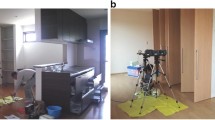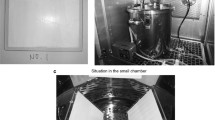Abstract
Volatile organic compounds (VOCs) may be emitted from surfaces indoors leading to compromised air quality. This study scrutinized the influence of relative humidity (RH) on VOC concentrations in a building that had been subjected to water damage. While air samplings in a damp room at low RH (21–22 %) only revealed minor amounts of 2-ethylhexanol (3 μg/m3) and 2,2,4-trimethyl-1,3-pentanediol diisobutyrate (TXIB, 8 μg/m3), measurements performed after a rapid increase of RH (to 58–75 %) revealed an increase in VOC concentrations which was 3-fold for 2-ethylhexanol and 2-fold for TXIB. Similar VOC emission patterns were found in laboratory analyses of moisture-affected and laboratory-contaminated building materials. This study demonstrates the importance of monitoring RH when sampling indoor air for VOCs in order to avoid misleading conclusions from the analytical results.
Similar content being viewed by others
References
Andersen I, Lundqvist GR, Mølhave L (1975) Indoor air-pollution due to chipboard used as a construction material. Atmos Environ 9:1121–1127
Blondeau P, Tiffonnet AL, Damian A, Amiri O, Molina JL (2003) Assessment of contaminant diffusivities in building materials from porosimetry tests. Indoor Air 13:310–8
Bruinen de Bruin Y, Koistinen K, Kephalopoulos S, Geiss O, Tirendi S, Kotzias D (2008) Characterisation of urban inhalation exposures to benzene, formaldehyde and acetaldehyde in the European Union: comparison of measured and modelled exposure data. Environ Sci Pollut Res 15:417–30
Chang JCS, Sparks LE, Guo Z, Fortmann R (1998) Evaluation of sink effects on VOCs from a latex paint. J Air Waste Manag Assoc 48:953–958
Claeson AS, Nordin S, Sunesson AL (2009) Effects on perceived air quality and symptoms of exposure to microbially produced metabolites and compounds emitted from damp building materials. Indoor Air 19:102–12
Farajollahi Y, Chen Z, Haghighat F (2009) An experimental study for examining the effects of environmental conditions on diffusion coefficient of VOCs in building materials. Clean-Soil Air Water 37:436–443
Gunschera J, Fuhrmann F, Salthammer T, Schulze A, Uhde E (2004) Formation and emission of chloroanisoles as indoor pollutants. Environ Sci Pollut Res 11:147–151
Huang H, Haghighat F, Blondeau P (2006) Volatile organic compound (VOC) adsorption on material: influence of gas phase concentration, relative humidity and VOC type. Indoor Air 16:236–47
Kim JL, Elfman L, Mi Y, Wieslander G, Smedje G, Norbäck D (2007) Indoor molds, bacteria, microbial volatile organic compounds and plasticizers in schools-associations with asthma and respiratory symptoms in pupils. Indoor Air 17:153–63
Korpi A, Jarnberg J, Pasanen AL (2009) Microbial volatile organic compounds. Crit Rev Toxicol 39:139–193
Lin CC, Yu KP, Zhao P, Lee GWM (2009) Evaluation of impact factors on VOC emissions and concentrations from wooden flooring based on chamber tests. Build Environ 44:525–533
Meininghaus R, Uhde E (2002) Diffusion studies of VOC mixtures in a building material. Indoor Air 12:215–222
Meininghaus R, Gunnarsen L, Knudsen HN (2000) Diffusion and sorption of volatile organic compounds in building materials—impact on indoor air quality. Environ Sci Technol 34:3101–3108
Mendell MJ (2007) Indoor residential chemical emissions as risk factors for-respiratory and allergic effects in children: a review. Indoor Air 17:259–277
Schleibinger H, Laussmann D, Bornehag CG, Eis D, Rueden H (2008) Microbial volatile organic compounds in the air of moldy and mold-free indoor environments. Indoor Air 18:113–24
Shin SH, Jo WK (2013) Longitudinal variations in indoor VOC concentrations after moving into new apartments and indoor source characterization. Environ Sci Pollut Res 20:3696–707
Sjöberg A, Ramnäs O (2007) An experimental parametric study of VOC from flooring systems exposed to alkaline solutions. Indoor Air 17:450–457
Swedish Standard Institute (2012) Indoor air—part 10: determination of the emission of volatile organic compounds from building products and furnishing - emission test cell method (ISO 16000–10:2006)
Tuomainen A, Seuri M, Sieppi A (2004) Indoor air quality and health problems associated with damp floor coverings. Int Arch Occup Environ Health 77:222–6
Van Netten C, Shirtliffe C, Svec J (1989) Temperature and humidity dependence of formaldehyde release from selected building materials. Bull Environ Contam Toxicol 42:558–65
Wieslander G, Norbäck D, Venge P (2007) Changes of symptoms, tear film stability and eosinophilic cationic protein in nasal lavage fluid after re-exposure to a damp office building with a history of flooding. Indoor Air 17:19–27
Wolkoff P (1998) Impact of air velocity, temperature, humidity, and air on long-term VOC emissions from building products. Atmos Environ 32:2659–2668
Wolkoff P (1999) How to measure and evaluate volatile organic compound emissions from building products. A perspective. Sci Total Environ 227:197–213
Won D, Corsi RL, Rynes M (2001) Sorptive interactions between VOCs and indoor materials. Indoor Air 11:246–256
Yang X, Chen Q (2001) A coupled airflow and source/sink model for simulating indoor VOC exposures. Indoor Air 11:257–269
Zhang JS, Zhang JS, Chen Q, Yang X (2002) A critical review on studies of volatile organic compound (VOC) sorption by building materials. ASHRAE Trans 108(1):162–174
Acknowledgments
This research was supported by the Swedish Research Council for Environment, Agricultural Sciences and Spatial Planning (FORMAS project 242-2008-343). We would like to thank Jörgen Grantén for assistance in some air measurements and access to a study building.
Author information
Authors and Affiliations
Corresponding author
Additional information
Responsible editor: Constantini Samara
Rights and permissions
About this article
Cite this article
Markowicz, P., Larsson, L. Influence of relative humidity on VOC concentrations in indoor air. Environ Sci Pollut Res 22, 5772–5779 (2015). https://doi.org/10.1007/s11356-014-3678-x
Received:
Accepted:
Published:
Issue Date:
DOI: https://doi.org/10.1007/s11356-014-3678-x




